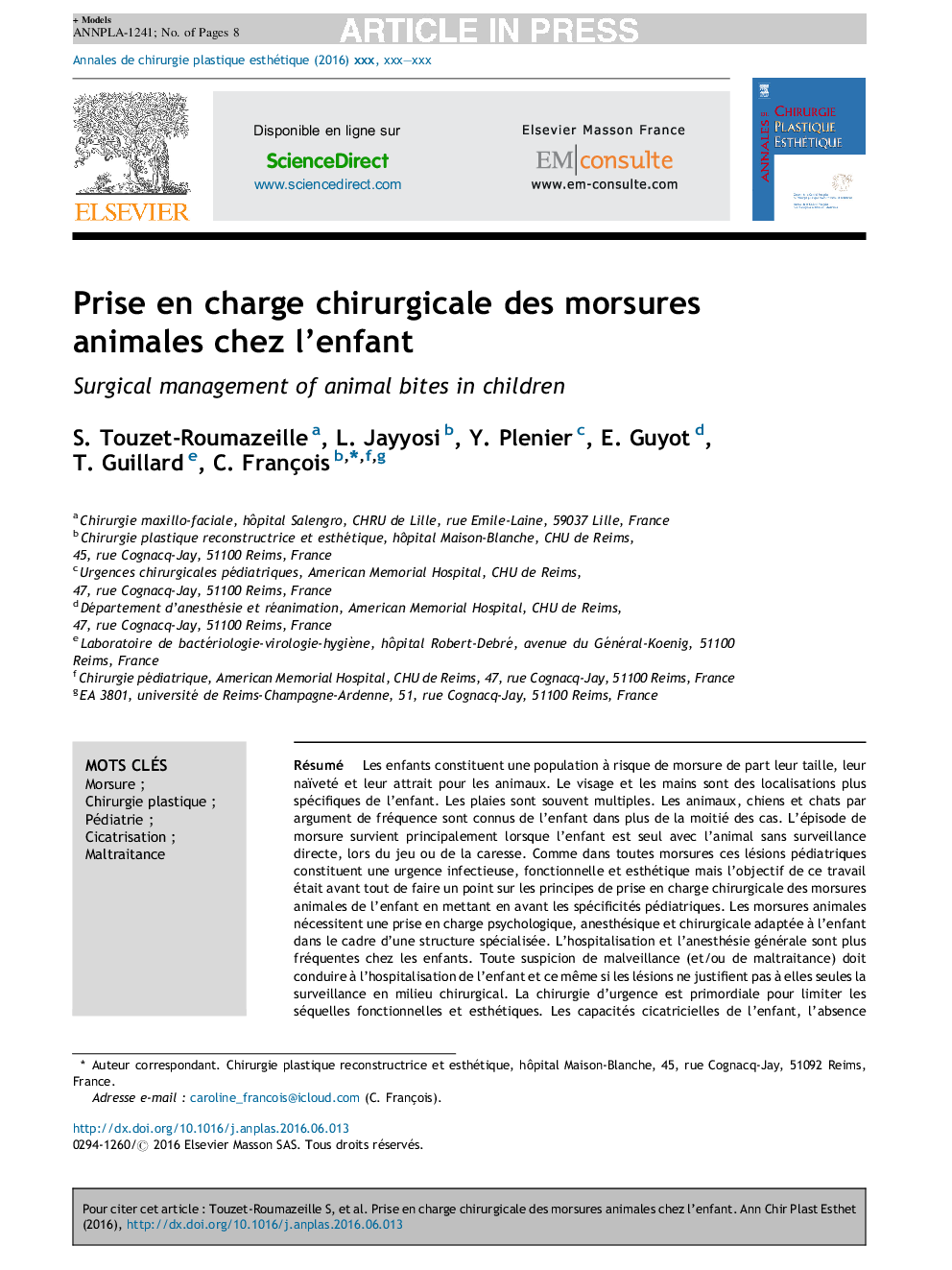| کد مقاله | کد نشریه | سال انتشار | مقاله انگلیسی | نسخه تمام متن |
|---|---|---|---|---|
| 5644598 | 1406996 | 2016 | 8 صفحه PDF | دانلود رایگان |
عنوان انگلیسی مقاله ISI
Prise en charge chirurgicale des morsures animales chez l'enfant
ترجمه فارسی عنوان
مدیریت جراحی نیش حشرات در کودکان
دانلود مقاله + سفارش ترجمه
دانلود مقاله ISI انگلیسی
رایگان برای ایرانیان
کلمات کلیدی
نیش می زنند، جراحی پلاستیک اطفال پا ©، شفا، دهید، نیش، جراحی پلاستیک کودکان، بهبود زخم، سوء استفاده از کودک،
ترجمه چکیده
کودکان به دلیل حجم کوتاه، نازیبایی و جذب آنها به حیوانات، جمعیت را به خطر می اندازند. چهره و دست ها مکان های ویژه ای در کودکان کم سن دارند. زخمها اغلب چندگانه هستند. در بیش از نیمی از موارد، کودک با شناسایی فرکانس، حیوان را می شناسد که سگ و گربه است. قسمت ناخن بیشتر اتفاق می افتد زمانی که کودک تنها با حیوان خانگی بدون نظارت مستقیم است، در حالی که بازی یا خیاطی حیوان است. همانطور که در تمام گزش ها، ضایعات اطفال در شرایط اضطراری عفونی، عملکردی و زیبایی شناختی قرار دارند، اما هدف این کار عمدتا به منظور تعیین اصول مدیریت جراحی نیش حشرات در کودکان، برجسته کردن ویژگی های کودکان است. گزش حیوانات نیاز به درمان روانشناختی، بیهوشی و جراحی دارد که در یک ساختار تخصصی متناسب با کودک است. بستری شدن و بیهوشی عمومی در کودکان بیشتر است. هر گونه سوء ظن بدرفتاری (و / یا سوء استفاده) باید به بستری شدن کودک منجر شود، حتی اگر زخم نظارت را در محیط جراحی توجیه ننماید. جراحی اضطراری برای محدود کردن عوارض عملکردی و زیبایی شناسی ضروری است. توانایی های درمانی کودک و کمبود مکرر آن، درمان جراحی محافظتی با سوزن را انجام می دهند، در عوض، جایگزین کردن فلپ های پوستی و کنترل جراحی می شود. امولسیون، زهکشی و آنتی بیوتیک عمل جراحی را کامل می کند. با این حال، روند بهبودی منجر به مدیریت خاصی در مرحله فاز بازسازی اسکار و رشد می شود. مراقبت روانشناختی از کودک و والدین نباید فراموش شود و باید همزمان با درمان جراحی در فاز حاد شروع شود.
موضوعات مرتبط
علوم پزشکی و سلامت
پزشکی و دندانپزشکی
امراض پوستی
چکیده انگلیسی
Children represent a population at risk, because of their short size, their naivety and their attraction to animals. The face and hands are the most specific locations in young children. Wounds are often multiple. In more than half the cases, the child knows the animal, which are dogs and cats by frequency argument. The bite episode occurs mostly when the child is alone with the pet without direct supervision, while playing or stroking the animal. As in all bites, pediatric lesions are infectious, functional and aesthetic emergencies, but the goal of this work was primarily to make a point on principles of surgical management of animal bites in children, highlighting pediatric specificities. Animal bites require psychological, anesthetic and surgical treatment, adapted to the child, in a specialized structure. Hospitalization and general anesthesia are more frequent in children. Any suspicion of mistreatment (and/or abuse) should lead to the child's hospitalization, even if wounds do not justify monitoring in a surgical environment. Emergency surgery is essential to limit functional and aesthetic consequences. The healing capacities of the child and the frequent lack of co-morbidity allow a conservative surgical treatment with suture, repositioning skin flaps and controlled healing in the first place. Immobilization, drainage, and antibiotics will complete the surgery. The healing process, however, leads to a specific management during scar remodeling phase and growth. Psychological care of the child and parents should not be forgotten, and has to start at the same time as surgical treatment at in acute phase.
ناشر
Database: Elsevier - ScienceDirect (ساینس دایرکت)
Journal: Annales de Chirurgie Plastique Esthétique - Volume 61, Issue 5, October 2016, Pages 560-567
Journal: Annales de Chirurgie Plastique Esthétique - Volume 61, Issue 5, October 2016, Pages 560-567
نویسندگان
S. Touzet-Roumazeille, L. Jayyosi, Y. Plenier, E. Guyot, T. Guillard, C. François,
